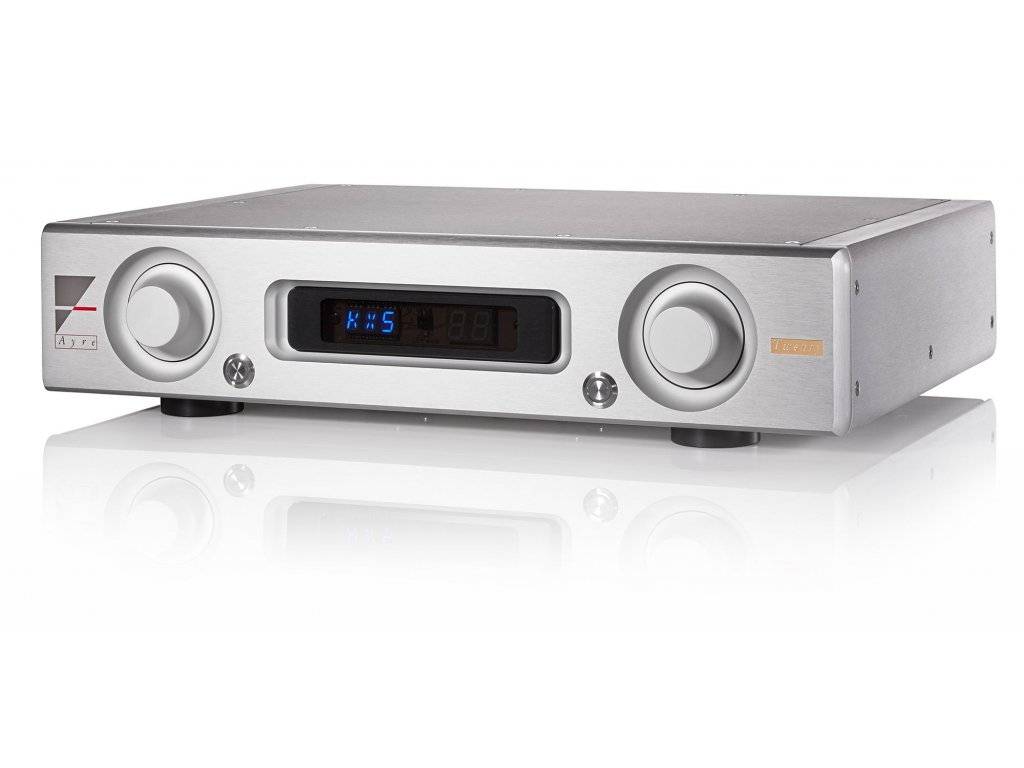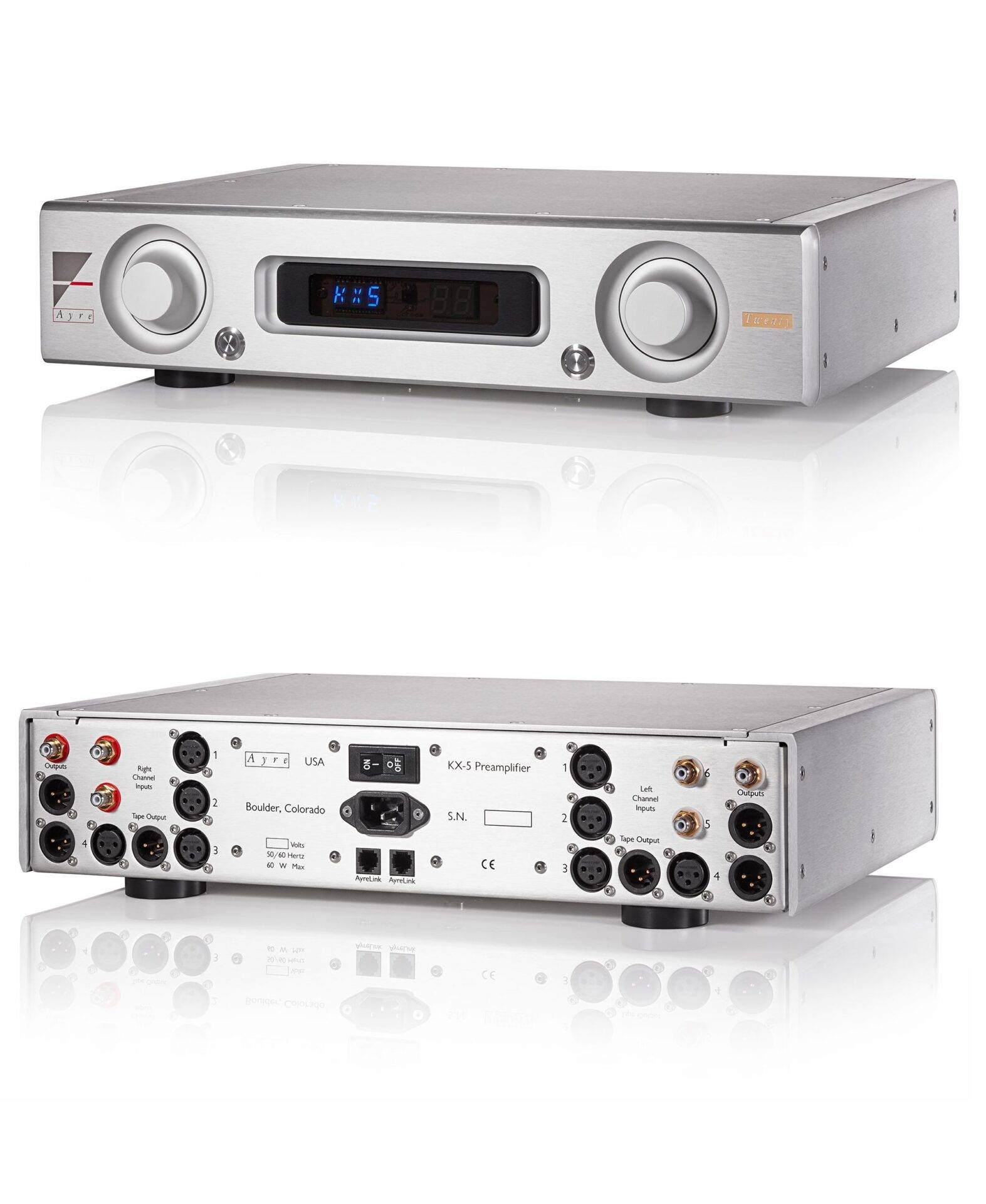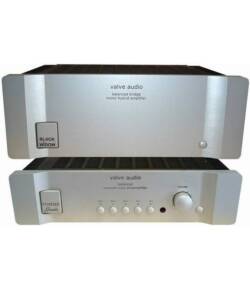Ayre Acoustics KX-5 Twenty line preamplifier
Original price was: R248,000.00.R90,000.00Current price is: R90,000.00.
Again a NEW product at crazy discount

The hoary question of tubes vs transistors, once certain and clear, is made ambiguous by recent products from a few solid-state specialists, not the least being Ayre Acoustics—the company that endures in the wake of the passing of its founder, the widely admired Charley Hansen. In their solid-state preamplifiers and amplifiers of the past decade in particular, Ayre has enshrined a number of technologies that are more than just variations on the audio-engineering status quo, and that appear to pay real sonic dividends.Consider Ayre’s Variable-Gain Transconductance (VGT) circuit, introduced in 2008 in their then-new KX-R preamplifier ($18,500 at the time). Instead of adjusting volume in the traditional manner—with a potentiometer that discards varying amounts of the product’s signal gain—each phase of each stereo channel of the VGT contains 46 discrete resistors that, selected with a rotary switch, create 46 distinct variations on the preamp’s voltage-gain stage, for a range of 46 volume levels. Thus there are fewer parts than usual in the signal path, and the preamplifier as a whole, from signal inputs through output buffer, is always maintaining an optimal S/N ratio.
In 2013, that and other Ayre technologies trickled down to their then-new KX-5 preamplifier, which since then has been rethought, redesigned, and, in 2015, recast as the KX-5 Twenty ($9950). “Twenty” refers to the number of years Ayre had been in business. In fact, they’ve now been in business for 24 years—but it’s taking a while for Ayre’s engineers to revamp everything in the line. And besides, who’s counting?
Description
The KX-5 Twenty is a solid-state, line-level preamplifier with six inputs—four balanced (XLR), two single-ended (RCA)—as well as balanced and single-ended outputs. Charley Hansen thought that balanced audio circuitry isn’t superior in and of itself, but rather that the technology’s advantages stem from its relative immunity to power-supply noise; in any event, Ayre has long offered adapters for converting their products’ unused balanced inputs to single-ended use.
Like the original KX-5, the KX-5 Twenty has a single gain stage, built with complementary pairs of J-FETs and incorporating the above-described VGT. Downstream from that stage is an active output buffer, each of its channels based on four bipolar transistors that comprise what Hansen described as the diamond circuit, named for its shape when drawn in schematic fashion (no precious gems were destroyed in the making of this preamp). Ayre’s take on the diamond circuit, which has historical precedent, provides current gain but not voltage gain; it bowed in their AX-5 integrated amplifier of 2012, in the role of the output stage.
Asked what distinguishes the KX-5 Twenty from the original KX-5, Ayre’s manager of sales and marketing, Brent Hefley, points to the Twenty’s AyreLock technology: an approach to power-supply design that uses discrete regulation devices instead of chips to create what Hefley describes as “a push-pull power supply—this one can pull voltage back down.” The power supply is also fully linear—at its heart is a hefty EI—as opposed to toroidal—transformer, which Ayre considers more suitable than toroidal types—and it also uses the proprietary AyreConditioner RFI filters on the incoming power line.
All of this is built into an aluminum enclosure 17.25″ wide by 4″ high by 12.25″ deep, with a brushed finish in silver or black. (My review sample was silver.) The KX-5 Twenty weighs a manageable 23 lbs, and is supported on four nonadjustable hard-polymer feet.
The interior is tidy and evidently well laid out. Setting aside the large power transformer—which is encased in a polished stainless steel wrap, the finish of which rivaled that of the preamp itself—I would estimate that the mechanical and electromechanical elements of the VGT system occupy as much interior space as the actual circuitry, most of the latter occupying a single 14″ by 3″ main circuit board, with two daughter boards, a front-panel logic board, and a dual-mono pair of boards fastened to the inside of the rear panel.
Also included is a slim, curvy, easy-to-hold remote-control handset with two separate banks of buttons, labeled Digital and Analog—this is a multiple-product control. The handset offers controls for volume, source selection, muting, and display brightness, but can’t be used for basic setup or advanced configuration chores. (The latter include the ability to tailor the gain of each input to match the source component connected to it.) The KX-5 Twenty has neither balance control nor mono switch.
Installation and Setup
Installation was easy: I plunked the KX-5 Twenty atop my Box Furniture rack, used its RCA jacks to make single-ended connections to my sources and amps—I don’t do balanced—and plugged its power cord into my AV Options power strip, using the outlet nearest the strip’s own AC cord.
Setup was less easy, especially inasmuch as the KX-5 Twenty, like the AX-5 integrated amplifier, is supplied with all its inputs deactivated: Until the preamp is configured, operating its left-hand control knob, which is designated for source selection—the right-hand knob is the volume control—has no effect, and no inputs are identified, by number or name, on the display that’s located between those knobs. Apparently this is so the user won’t have to activate any more inputs than he or she actually needs, meaning that, for those who have fewer sources, browsing the inputs will take less time.
But Ayre’s regimen for configuring and activating inputs is less than intuitive, a shortcoming made worse by an unclear owner’s manual that devotes page after page to secondary matters while giving short shrift to essentials—something I believe I have noted in past Ayre reviews. The manual is reasonably clear on how to enter the preamp’s setup mode—this and other procedures involves the use of one of two front-panel buttons, full descriptions of which are beyond the purview of a product review—in which the six inputs and their naming possibilities are easy to call up, yet the manual gives not a hint as to how, precisely, one selects the desired name. (It turns out that, during scrolling, to simply leave a name onscreen for a certain amount of time before proceeding to the next step is to select it.)
In my opinion, the Ayre newbie who wants to use their new $10,000 preamp to listen to music right away, or even soon, would be better served by having all inputs preconfigured and numbered 1 through 6. That eager user can then ditch unneeded inputs and change to fancier, more germane names later. Perhaps, then, the Quick Start portion of the KX-5 Twenty owner’s manual, which presently numbers 14 of a total of 36 pages, could be whacked down a mite. Also, though the manual instructs the user how to put the KX-5 into Sleep mode, it offers no clue about how to wake it. Turns out that one quick press of the same button does that. Ayre perhaps considered this sufficiently intuitive—it was, I admit, the first thing I tried—but its omission from the manual seems glaring.
Even when I began playing music, the KX-5 Twenty’s user interface hindered rather than helped: With a CD playing in my Sony disc player, and with the appropriate input selected and the preamp’s volume turned up to “20” (of a range of “0” to “46”), the signal still wasn’t making its way through my amplifier and speakers. I’d assumed the Ayre wasn’t muted because, according to the manual, when Mute is activated, whether via the remote or the front panel, this “temporarily [turns] the volume of the KX-5 to ‘zero'”—and the front-panel display still read “20.” It turns out that when Mute is activated, “0” or even “zero” does not appear on the display—rather, Mute is visually indicated by the display illuminating all of its decimal points. If there’s a less intuitive way of getting across the notion of mute, I can’t imagine it.
The user interface and owner’s manual both need work.
Listening
Happily, the Ayre KX-5 Twenty sounded good. Really damn good.
As my listening notes remind me, singer Lee Feldman’s voice in “Give Me My Money,” and in other songs from his indispensable I’ve Forgotten Everything (CD, Urban Myth UM-114-2), sounded “amazing: lifelike and present and lacking in timbral colorations or other distortions.” In “Me and My Sara Remaining,” the way the accordion insinuates itself into the song was real and right, and in “Hippy Store,” the sense of the backing combo—electric guitar, electric bass, Hammond organ, drums—playing between my speakers was uncanny. As I came to realize during its time in my system, the KX-5 Twenty was virtually unparalleled in its ability to suggest scale and spatial perspectives. With this disc, the only respect in which the Ayre could be bettered was its slight lack of texture in the sounds of the electric bass (although notes in the acoustic piano’s left hand sounded “stringy” enough).
That lack of texture followed the Ayre to Leonard Cohen’s second album, Songs from a Room (CD, Columbia/Legacy 88697 04740 2), on which the sound of the double bass was a little too smooth and rounded over. At this point in my listening I paused and double-checked these observations by reinstalling, for a couple of hours, my Shindo Laboratory Monbrison preamplifier—the differences between the two products’ portrayals of sonic textures were quite apparent. But notes from that double bass were clear of pitch, and nimble. Voice articulation was superb without being clinical—especially in “The Partisan,” I found it easier than ever to understand the three verses sung in French. More important, every song on this album was as moving as I always hope and expect them to be.

Sonic touch and force came across well through the KX-5 Twenty, albeit not quite as well as through the very best preamps I’ve heard. The soft, pizzicato cellos and double basses that begin Bruckner’s Symphony 5, in a recording by Jascha Horenstein and the BBC Symphony Orchestra (CD, Intaglio INCD 7541), had decent pluck. At the other end of the scale, louder passages came across with clarity and poise: Never once did the music sound harsh or pinched or smaller than it should. In a larger and altogether more important musical sense, the Ayre allowed the Bruckner its strength of line and sense of purpose: heard through this preamp, every minute was electric.
The KX-5 Twenty also did well with rowdier music. In “Tanya,” from Dexter Gordon’s One Flight Up (LP, Blue Note/Cisco Music BLP 84176), the tension in Niels-Henning Ørsted Pedersen’s double-bass lines—especially his double-stops later in the track—came across very well, and the sound of Art Taylor giving his drums hell was a delight. On this recording as others, more texture—in the sounds of all the instruments, really—can be had through better and generally more expensive electronics, but I found the Ayre satisfying, Gordon’s tenor sax sounding especially good. And from a recently acquired mono copy of the Yardbirds’ Five Live Yardbirds (LP, UK Columbia 33SX 1677), the sound of the 19-year-old Eric Clapton’s electric guitar fairly leapt from the speakers. Hearing that record through the Ayre had me thinking not about spatial this or color that, but about what a great, raw-sounding band that was!
Indeed, I suppose the truest test of any piece of audio gear is its ability to connect the listener with the music, as when the product allows its user to appreciate new or heretofore underappreciated music. So it was when I played Grieg’s incidental music from Peer Gynt, performed by Øiven Fjeldstad and the London Symphony Orchestra (CD, London/Classic Compact Discs CSCD 6049). I’ve always considered Grieg a second-rate composer (and not even a first-rate second-rate composer, as Richard Strauss once described himself), and I’ve tended to regard the Peer Gynt music in particular as nationalistic fluff, but minus the spark of genius that informed, say, Elgar’s nationalistic fluff. I reached for this CD only because I knew it to be a recording of very high quality: the cardinal audiophile sin. But through the Ayre, that music steadfastly refused to be taken as mere audio-review fodder, and I found myself drawn into Grieg’s melodies and orchestrations as never before. And I couldn’t help hearing how the third selection, The Death of Ase, might have influenced Franz Waxman’s brilliant score for The Bride of Frankenstein. So in the best of ways, the KX-5 Twenty earned its keep.
A final note: On the Ayre’s last day here I unplugged it, removed its top cover, and had a look inside—after which I replaced the cover and remade all the connections, hoping to listen to just a few songs more. But when I flipped its rear-panel power switch, a single red light and the letters AC, in blue, appeared on the display. I consulted the manual and learned that this was the preamp’s way of telling me that my household AC wasn’t serving up the correct voltage. I shut down the preamp, measured my household current—a perfect 120V—and started over. This time there was no warning message, and everything worked just fine. I doubt that this episode reflects a problem of any sort—perhaps the line voltage had dipped overnight? I mention it here only in the interest of t-crossing and i-dotting.

Conclusions
I enjoyed the time I spent listening to the KX-5 Twenty—the time spent interacting with it, less so—and although I prefer the sound of my all-tube Shindo Monbrison preamp, the Ayre’s remarkable and utterly nonclinical clarity, and its convincing, commandingly good spatial performance, made big impressions on me. Sonically, musically, and as a product of 21st-century American audio craftsmanship—that VGT system really must be seen to be appreciated (footnote 1)—the KX-5 Twenty offers decent value, especially to hobbyists who already own an Ayre amplifier; those who are starting from scratch and who enjoy Ayre’s house sound might consider spending another $5000 and buying, instead, their AX-5 Twenty integrated amplifier. Recommended.
Description
Ayre’s Diamond output stage
Variable Gain Transimpedance (VGT) volume circuit
Ayre’s exclusive Equilock circuit
46 step volume control, each of 1.5 dB
Linear analog power supply
zero-feedback and fully-balanced discrete circuitry
High-speed circuit board material
Input ground switching for true source isolation
Six inputs: four balanced, two single-ended
Ayre Conditioner power line RFI filter
AyreLink communication system
Maximum Input Level
8 V rms – unbalanced inputs
16 V rms – balanced inputs
Gain
Gain Variable to match the required output level of the system without the need for attenuation.
Input Impedance
1 MΩ unbalanced inputs
2 MΩ balanced inputs (1 MΩ per phase)
XLR Input Polarity
Pin 1 = Ground
Pin 2 = Non-inverting (Positive)
Pin 3 = Inverting (Negative)
Frequency Response
DC – 250 kHz
Power Consumption
40 watts in operating mode
60 watts in operating mode (volume control active)
Dimensions
17.25″ W x 13.25″ D x 3.75″ H
(44cm x 34cm x 10cm)
Weight
23 pounds (10.5 kg)





